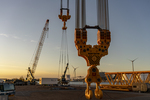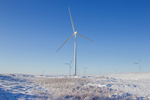05/19/2005
Global wind map may provide better locations for wind farms I
A new global wind power map has quantified global wind power and may help planners place turbines in locations that can maximize power from the winds and provide widely available low-cost energy. After analyzing more than 8,000 wind speed measurements in an effort to identify the world's wind power potential for the first time, Cristina Archer and Mark Jacobson of Stanford University suggest that wind captured at specific locations, if even partially harnessed, can generate more than enough power to satisfy the world's energy demands. Their report will be published in May in the Journal of Geophysical Research-Atmospheres, a publication of the American Geophysical Union.
The researchers collected wind speed measurements from approximately 7,500 surface stations and another 500 balloon-launch stations to determine global wind speeds at 80 meters [300 feet] above the ground surface, which is the hub height of modern wind turbines. Using a new interpolation technique to estimate the wind speed at that elevation, the authors report that nearly 13 percent of the stations they reviewed experience winds with an average annual speed strong enough for power generation. They note that, based on their expectations of other global areas, an even greater percentage of locations would likely reach the 6.9 meters per second [15 miles per hour] wind speed considered strong enough to be economically feasible.
Such wind speeds at 80 meters, referred to as wind power Class 3, were found in every region of the world, although North America was found to have the greatest wind power potential. The researchers also found that some of the strongest winds were observed in Northern Europe, along the North Sea, while the southern tip of South America and the Australian island of Tasmania also recorded significant and sustained strong winds at the turbine blade height. In North America, the most consistent winds were found in the Great Lakes region and from ocean breezes along the eastern, western and southern coasts. Overall, the researchers calculated winds at 80 meters [300 feet] travelled over the ocean at approximately 8.6 meters per second and at nearly 4.5 meters per second over land [20 and 10 miles per hour, respectively]…
The researchers collected wind speed measurements from approximately 7,500 surface stations and another 500 balloon-launch stations to determine global wind speeds at 80 meters [300 feet] above the ground surface, which is the hub height of modern wind turbines. Using a new interpolation technique to estimate the wind speed at that elevation, the authors report that nearly 13 percent of the stations they reviewed experience winds with an average annual speed strong enough for power generation. They note that, based on their expectations of other global areas, an even greater percentage of locations would likely reach the 6.9 meters per second [15 miles per hour] wind speed considered strong enough to be economically feasible.
Such wind speeds at 80 meters, referred to as wind power Class 3, were found in every region of the world, although North America was found to have the greatest wind power potential. The researchers also found that some of the strongest winds were observed in Northern Europe, along the North Sea, while the southern tip of South America and the Australian island of Tasmania also recorded significant and sustained strong winds at the turbine blade height. In North America, the most consistent winds were found in the Great Lakes region and from ocean breezes along the eastern, western and southern coasts. Overall, the researchers calculated winds at 80 meters [300 feet] travelled over the ocean at approximately 8.6 meters per second and at nearly 4.5 meters per second over land [20 and 10 miles per hour, respectively]…
- Source:
- Online editorial www.windfair.net
- Author:
- Trevor Sievert, Online Editorial Journalist
- Email:
- press@windfair.net
- Keywords:
- Wind mapping, Standford university, wind energy, wind power, wind turbine, wind farm, rotor blade, renewable energy, offshore, onshore
Related News
China, Brazil Partnership
11/21/2024


























